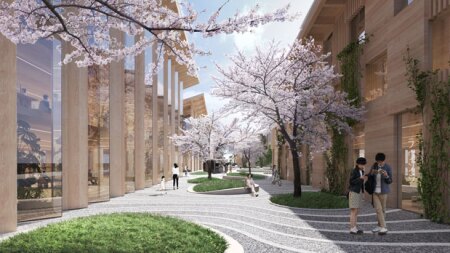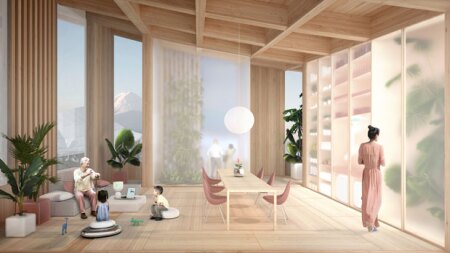Employees, business partners, and others may set up housekeeping and create a real-life test environment for new technologies in autonomous vehicles, artificial intelligence (AI), and robotics.
Ground breaking is expected in 2021 for an ambitious new product from Toyota Motor Corporation: a ground-up smart city in Japan where the company plans to stage a real-life, extended-duration test of Toyota initiatives in self-driving vehicle systems, robotics, and renewable energy.
The Japanese automaker announced plans earlier this year not at an automotive trade show or an urban planning conference, but at CES, the high-profile technology trade show held annually in Las Vegas.
“Currently, we research and test this technology in various labs around the world,” Akio Toyoda, president of Toyota Motor Corporation, announced. “But it occurred to us: what if we had the opportunity to do it all in one place, in a real-life environment, instead of a simulated one?”
The company’s plan is to create Woven City, a roughly 175-acre (71 ha) municipality of 2,000 or more to be developed on the site of an auto manufacturing plant scheduled for closure in Higashi-Fuji, within sight of Mount Fuji in Japan.
As Toyoda and architect Bjarke Ingels of Bjarke Ingels Group (BIG) explained during their presentation, Woven City is planned to shift transportation of people and goods to autonomous shuttles. These wheeled Toyota vehicles will operate both in a network of tunnels and along shared streets optimized for pedestrians like the curbless woonerfs becoming popular in new, vibrant mixed-use developments around the world.
Narrower byways in Woven City will welcome people on foot and those on bikes and scooters, while the narrowest, most park-like passages will be reserved for pedestrians.
“This not only creates a more serene living environment, but also provides a wide variety of intersections between various kinds of users—between humans, animals, and vehicles, and even robots,” Ingels said.
Toyota is touting a “fully sustainable” design that will have Woven City’s buildings constructed mostly out of wood—an old technique gaining renewed popularity in commercial construction—and partly by robots. The development’s microgrid will rely on rooftop solar panels as well as fuel cells that combine hydrogen and oxygen to generate electricity, with water as their exhaust. Plans call for both traditional landscaping and hydroponic gardens.
The first 2,000 residents—Toyoda said that they will be “Toyota employees and their families, retired couples, retailers, visiting scientists, industry partners”—will live and work in spaces teeming with sensors and computing power.
“These smart homes will take advantage of full connectivity using sensor-based AI to do things automatically like restocking your fridge or taking out your trash or even taking care of how healthy you are,” Ingels said.
(As for the city’s name, Toyoda nodded to Toyota’s beginnings as a loom manufacturer: “We began by weaving fabric, and now we hope to use our technology to weave together a new kind of city and a new way of enjoying life.”)
Toyota’s show-floor exhibit featured one of the rectangular e-Palette autonomous shuttles intended to roll people around Woven City (and which were to convey passengers around the Olympic Village this summer in Tokyo) and function as a shop on wheels selling everything from pizzas to gadget-repair services, plus a smaller Micro Palette delivery robot that can carry groceries or meals.
Near a tabletop model of Woven City, a wraparound video wall showed people enjoying the city’s cherry blossom–lined plazas on foot as well as on bikes and scooters while e-Palettes made their way about, some taking ramps to reach the higher floors of buildings topped by solar panels.
It all looked idyllic. But companies and governments have been trying to build the towns of tomorrow for decades, and the experience offers many reasons for caution. One recurring critique is public alarm over the ownership and use of the tremendous amount—and often personal nature—of the data collected. Toyota’s Woven City presentation at CES, however, emphasized the role of this development as an ongoing experiment that should yield measurable data.
“With people, buildings, and vehicles all connected and communicating with each other through data and sensors, we will be able to test AI technology in both the virtual and the physical world, maximizing its potential,” Toyoda said.
He acknowledged concerns over AI’s misuse, but did not get into details: “In a world where the negative aspects of artificial intelligence seem to be on the rise, this will be an opportunity to apply it with integrity and trust.”
Optimizing for Autonomy
While the privacy concerns in Woven City’s design may not be novel, Toyota’s intention to rely solely on autonomous vehicles for moving people and goods around sets it apart from such earlier projects as Peña Station Next, a development outside Denver. It could be viewed as a prototype for Woven City, down to its announcement at CES by a Japanese firm: Panasonic announced Peña Station Next in 2016 as a way for the company to show off its renewable energy and smart-city efforts.
The residents of the hundreds of apartments at Peña Station Next can take autonomous shuttles to the nearby Regional Transportation District (RTD) commuter-rail station. But they also are welcome to keep their own cars—although the development’s parking lots are topped by solar panels that feed into local battery storage, making the development greener even with continued use of gas-fueled vehicles.
The same is true of what may be the largest smart-city project, Songdo, South Korea. That project near Incheon International Airport may have dispensed with garbage trucks—instead, a series of tubes whisks away trash to be recycled or burned for fuel, somewhat like the tunnels to be built under Woven City—but it also includes underground parking garages.
Woven City’s location will allow for convenient car-free travel to Tokyo, about 60 miles (96 km) away in a straight line, and other nearby cities: a Japan Rail East station stands just outside its boundaries.
The most immediate issue with Woven City moving all transport to robots on wheels may be the need for them to steer clear of all the nearby humans on these shared streets.
Lisa Nisenson, vice president for new mobility and connected communities at the West Palm Beach, Florida, design firm WGI, noted the care that early autonomous-shuttle operators are taking in the United States—one Florida project she studied has mandated a three-foot (0.9 m) gap between vehicles and any people.
“You have a lot going on in these very concentrated spaces,” Nisenson said of developments like Woven City. “If everything has to have this six-foot [1.8 m] clear zone around it, you’re basically turning the city into a suburb.”
Robot/human interactions on streets and sidewalks—as Ingels touted in his CES presentation, a routine part of daily life in Woven City—can also take unexpected directions.
For example, while Starship Technologies’ six-wheeled delivery robots have been generally popular on the suburban campus of George Mason University in Fairfax, Virginia, the University of Pittsburgh paused its testing in October 2019 after a student in a wheelchair reported that one of these four-mile-per-hour (6 kph) robots blocked her access to a curb ramp.
“You’re starting to get all of these new gadgets, mobility gadgets, that are all going different miles per hour, and they’re all going to have to mix in the same infrastructure,” Nisenson said.
Nico Larco, codirector of the University of Oregon’s Sustainable Cities Institute, did, however, give Toyota credit for extrapolating intelligently from current trends.
“I think it’s very plausible that 20 years from now, 30 years from now, there are few to no privately owned vehicles,” he said. “Everything is in fleets.”
A Company Town
As Larco alluded to, in one sense, Toyota is building Woven City on a pattern that we have seen before—that of prior attempts to build a town of tomorrow that began with assumptions that one technology of the day would triumph.
“The history of projects that try to do things like this has not been stellar,” he said. “Typically, the problem is that they lead with technology, and people’s lives are not about technology.”
Toyota will not, however, have to deal with the typical consequences of community disapproval. People who will live in Woven City should know what they have signed up for—many will be employees and others with a vested interest in the community’s success. “This is a company town,” Larco said. And that usually comes with a tradeoff of control—autonomous vehicles for everyone, but at the price of civic autonomy.
For example, he asked, how will Woven City’s retail spaces get allocated and reallocated as tastes change, and how much unplanned civic interaction will that allow? How will a vibrant street life develop?
“My shopping trip’s not just about me acquiring a commodity,” Larco said. “I’ll see a friend who’s out there; you experience the world; you’re part of the street life.”
He continued: “As more and more of these things are automated, how do they envision this kind of street life happening?”
Toyota already is a partner with the University of Michigan’s Mcity research project. That mock town built in Ann Arbor, Michigan, allows self-driving vehicles to roam roads without putting people at risk. But with Woven City, Toyota is setting its aspirations higher by incorporating humans with day jobs and weekend pursuits into its design, even though they will complicate the experiment.
“They’ll probably learn a lot of lessons about how to deploy a technology and how to fine-tune a technology,” Larco said. “I don’t think they’re going to be learning that much about how a real community interacts.” His three-word summary of the project: “a noble effort.”
ROB PEGORARO is a freelance technology writer in Arlington, Virginia.










